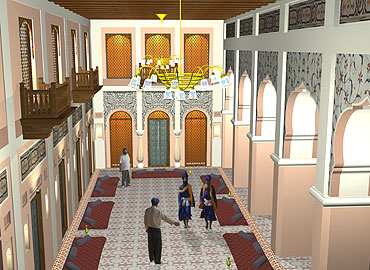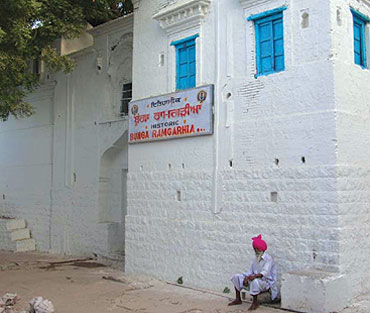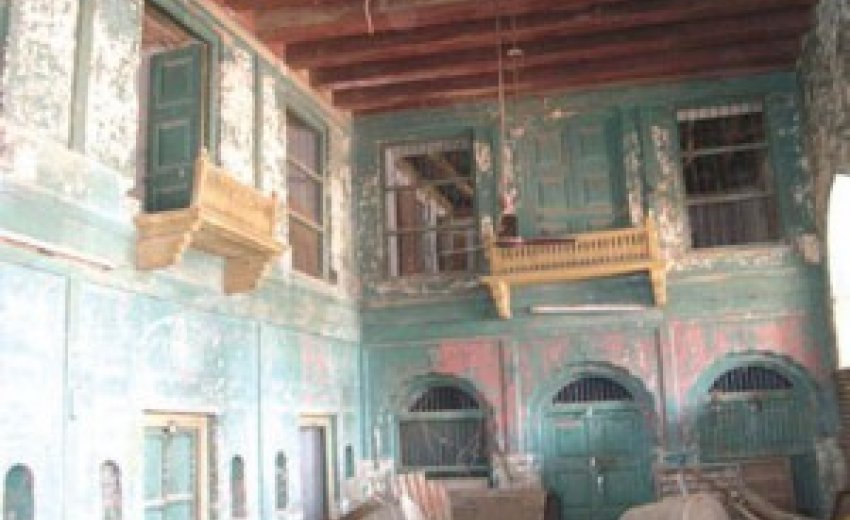Sikhism's heritage is being pulverised by a blend of ignorance, arrogance, new money

Hall Gurudwara Hazoor Sahib
Heritage Mauled
05 May, 2008: In the name of kar seva, historic Sikh structures are being demolished:
- Part of the 150-year old Gurudwara Hazoor Sahib in Nanded was razed
- The 500-year-old home of Bebe Nanki (elder sister of Guru Nanak) also met the same fate
- Homes of Sikh gurus Amar Das and Ram Dass in Amritsar were razed
- According to INTACH 90 per cent of all ancient Sikh buildings in Punjab have been demolished
In the dead of the night, sometime in October last year, police surrounded the historic baradari at Gurudwara Hazoor Sahib in Nanded, Maharashtra, built during Maharaja Ranjit Singh's reign. Under their watchful eye, the once-magnificent structure was razed to the ground, even as conservationists who had drawn up detailed plans to restore it were pleading with the gurudwara management to preserve the 150-year-old building. It was 300 years ago, in October 1708, that Guru Gobind Singh, the tenth Sikh guru, bestowed the guardianship of the faith on the Guru Granth Sahib at this very spot. Since then, Hazoor Sahib has been revered as one of the four takhts of Sikhism.
What happened at Nanded in October and before that in January 2007, when another historic structure in the complex, the Ramgarhia Bunga, was similarly demolished, leading to rioting by local Sikhs and police firing, has become a recurrent story with Sikh historic monuments across the country. In the face of sharp criticism by conservationists and Sikh intellectuals in Punjab and elsewhere, as well as vigorous online campaigns spearheaded by expatriate Sikhs to preserve their heritage, the keepers of these monuments have brazenly continued their wanton depredation. Gurmeet Rai, director of intach's Cultural Resource Conservation Initiative (CRCI), who has restored several ancient Sikh historical buildings in Punjab, says, "I would say 90 per cent of Sikh heritage monuments have been destroyed in Punjab in the name of renovation and kar seva." Kar seva is a unique institution in Sikhism, wherein the community collects funds or volunteers its labour to repair or build religious structures, generally gurudwaras. Why and how did things come to this pass?

Model for the renovated hall
"Though kar seva babas had been renovating gurudwaras ever since anyone can remember, it was after Operation Bluestar, when the Sikh community donated generously for the massive rebuilding of the Golden Temple premises, that 'babas' began to appreciate the money-making opportunities such rebuilding threw up. The trend then spread across Punjab and in the last two decades, old heritage structures began to be demolished and replaced by garish, opulent marble gurudwaras", says H.S. Dilgeer Singh, a Sikh historian. Adds Rai, "These pseudo-babas are armed with so much money but they spend it foolishly on rebuilding instead of restoration, because they are absolutely ignorant about the historical value of these old monuments. Somewhere along the line, the original, unpretentious Sikh architecture has begun to be perceived as something to be ashamed of. Our Gurus were simple, down-to-earth men of the soil, and their buildings reflect the simplicity and harmony which Sikhism is all about."
It was this very simplicity of the Ramgarhia Bunga and the Baradari at Nanded which brought about their destruction. Dr P.S. Pasricha, present chairman of the Hazoor Sahib Gurudwara Board and former director-general of police, Maharashtra, told Outlook, "The Baradari was a dilapidated structure which was coming in the way of the huge development plans currently being executed for the celebrations of the 300th anniversary of the guruship of the Guru Granth Sahib at Nanded this year. As far as I am aware, it had no historical value. As for the Ramgarhia Bunga, it was an old room with two tin trunks in it. We have now given 3,000 sq ft of land at another place to the Ramgarhias to construct a new 31-room sarai with a museum. We are making the place an international pilgrimage destination. Besides the Rs 125 crore which the board is spending on the gurudwara project, the town of Nanded too is getting a facelift, for which the Planning Commission has earmarked Rs 1,500 crore."

The Ramgarhia Bunga, pulled down in Jan 2007
But what Pasricha and his cohorts do not talk about is the painstakingly elaborate restoration plans made by Sharad Chalikwar, a consultant engineer with the board and Kiran Kalamdani, a restoration architect from Pune once associated with the project. "I spent two years drawing up the plan for the Baradari, but was forced to dissociate myself from the project when it was demolished despite our pleas. They are bulldozing their own heritage," says Chalikwar. Adds Kalamdani, who was originally appointed to conserve the Baradari, "We were thrown out along with the demolition of these monuments. All that matters to them is the desire to make grand structures." Both the Baradari and the Bunga were built by Maharaja Ranjit Singh. The destruction at Nanded is particularly unfortunate because it was done under the supervision of a top police officer and not some ignorant kar seva baba.
Back home in Punjab, the list of Sikh heritage structures which have fallen at the hands of overzealous babas is growing too. Dr Gurtej Singh, a Sikh scholar, lays the blame at the door of the Sikh leadership of recent times. "Whether it is the Shiromani Gurudwara Prabandhak Committee or the Akal Takht or even the political Akali Dal which draws its strength from the former two, there is no appreciation for our heritage. Scholars like us do not matter in the scheme of things, because we obstruct their commercial aspirations. The sgpc patronises these babas and they do not realise that they are converting history into mythology by destroying historical evidence." Take the case of the 500-year-old house of Bebe Nanki (elder sister of Guru Nanak) in Sultanpur Lodi. A few years ago, it was bought up by one Baba Jagtar Singh and was demolished in 2003. A sparkling white marble building now stands in its place. The old homes of two Sikh gurus, Amar Das and Ram Dass, which stood in Amritsar till a few years ago, were pulled down and shining new gurudwaras erected in their place. The same fate has befallen Gurudwara Jyoti Swarup at Sirhind where the two sons of Guru Gobind Singh were cremated, and Shahid Ganj near Mani Sahib Hall near Amritsar, the site of the mass cremation of Sikh martyrs who fought against Ahmed Shah Abdali. The peeling, faded frescoes at Baba Atal Gurudwara in Amritsar and at Baba Bakala in Gurdaspur were removed and replaced by common ceramic tiles, much to the anguish of educated Sikhs. Why, even the Golden Temple at Amritsar was not spared—frescoes in its Darshani Deori were whitewashed some years ago and the 'renovation' was stopped only when the matter was raised in the local media.
But who shall bell the cat? Or is it too late already to launch a strong protest? If community leaders are apathetic to the obliteration of their spiritual heritage being done with the active collusion of religious leaders, is there hope for Sikhism's architectural heritage, much of which has already fallen prey to insensitivity and greed?

